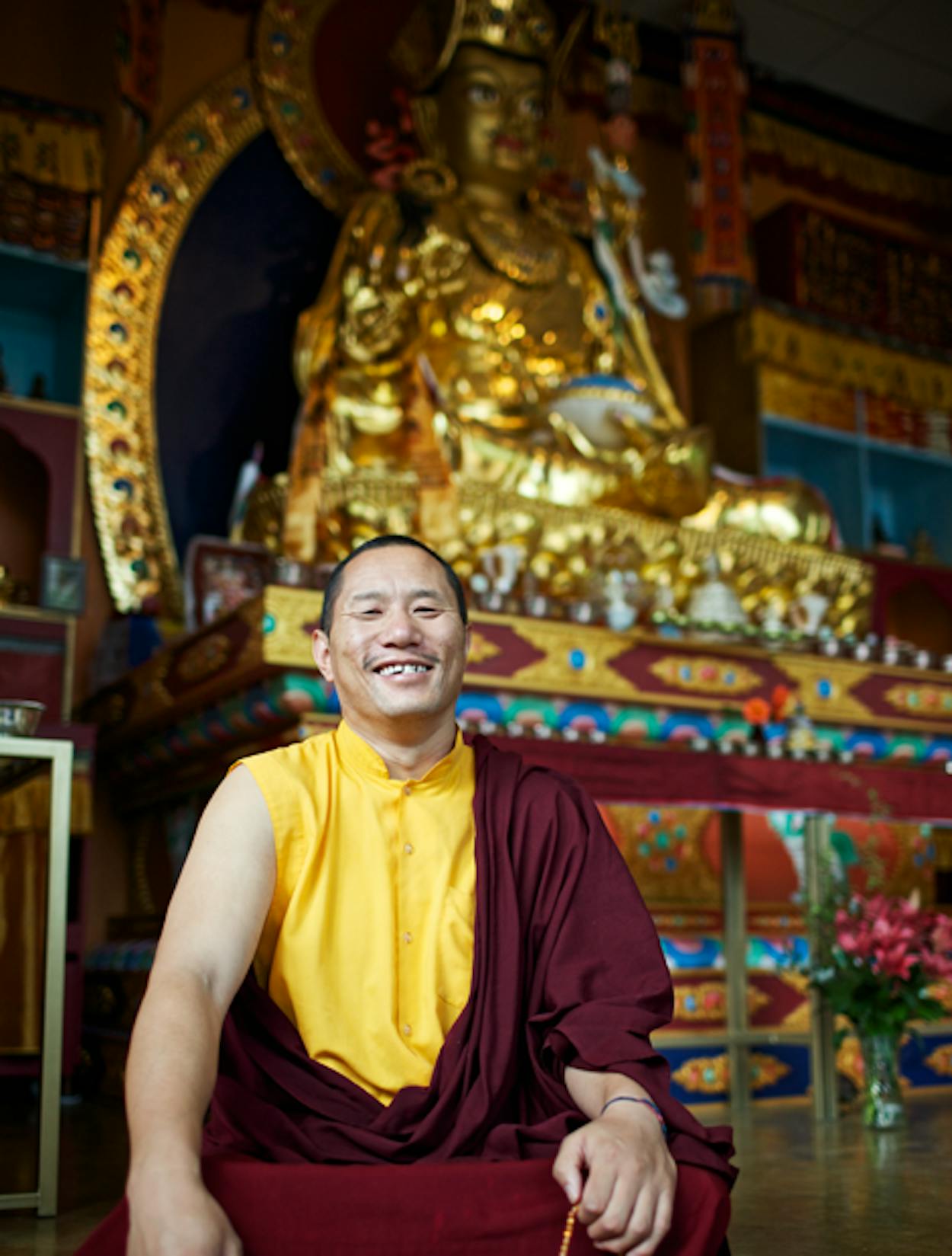Each morning Lama Lobtsul, the Lama in residence at the Palri Pema Od Ling Buddhist center in Austin, enters the temple and performs the important task of arranging offerings of water, candles and incense in front of the rare statue of Guru Rinpoche.
The thirteen-foot-tall, 2,500-pound brass representation of the India Buddhist master who brought Buddhism to Tibet in the eighth century radiates like a beacon from behind picture windows overlooking busy 45th Street, across from the Hyde Park Christian Church, in a mostly residential area.
“If you make aspirations in front of the statue,” said Lama Lobtsul via Ila Reitz, his translator, “then it will be of great benefit to you in this life and future lives—just as if you were in front of Guru Rinpoche.”
There is more to the statue than meets the eye. It is filled with medicines, mantra prayers and approximately one thousand books, including the canonical text and teachings of the Buddha. It is also heavy with flashy adornments, among them a trident, the staff of which is made of three heads representing the three kayas, or expressions of the Buddha. In Guru Rinpoche’s lap sits a blue, white and gold kapala, or “skull cup,” filled with a nectar that represents spiritual awakening.
“Tibetans are big on bling,” said Reitz, a student of Buddhism who is affiliated with the Tashi Choling center in Oregon.
The statue is one of only two of this particular mold of Guru Rinpoche on display in the United States (the other is in Alameda, California). There are 23 more scattered around the world, mostly in Europe and Asia. Collectively, they represent the Padmasambhava Global Project for World Peace, started in 2002 by Khenpo Namdrol Rinpoche, a Buddhist teacher based in Nepal. According to the project’s website, the statues are meant to “deter negativity and spread blessings of compassion and wisdom.”
While the statue alone makes Palri Pema Od Ling extraordinary, the added presence of Lama Lobtsul makes Austin more attractive as a place to seriously study Buddhism—an alternative to California and New York, where the practice has thrived since the 1960s.
“I’m sure he won’t tell you this, but he was really quite a high Lama where he came from,” said David Lunsford, a former Dell employee who was integral in establishing Palri Pema Od Ling in 2008. “He’s been instructed by the real thing—the really authentic teachers.”
Lama Lobtsul’s direct lineage to the original teachers sets this temple apart from the Buddhist centers in the United States that are led by American practitioners. It is an anomaly to have a genuine Tibetan Buddhist available to provide instruction to anyone who walks through the door.
“I can only name a few places that have that,” Lunsford said.
Lama Lobtsul’s road to Texas dates back to when he was eleven. His father had just died, leaving him with the responsibility of caring for his mother and younger siblings, nomads based in the mountains near the Yellow River. By day, he would tend to three hundred head of sheep and other livestock. By night, he would practice his faith, even though it was discouraged by the Chinese government, which had spent years trying to eradicate the religion.
“We would come in secret, not wearing monks’ clothing, and practice for three hours and go away,” Lama Lobtsul, 43, said over tea and homemade peanut-butter cookies in his modest living space. “During my whole childhood, Buddhism was absolutely, completely prohibited. If someone saw you doing a Buddhist mantra, they would arrest you and you would be very strongly punished.”
But Lama Lobtsul persevered, and at 21 he attained the title of Lama, or teacher, eventually becoming master of ceremonies at his monastery. This set him on a spiritual path from Tibet to India, where he studied with the Dalai Lama, and then in 2008 to Colorado, where he practiced at the Boulder Shambhala Center, and finally, in February, to Palri Pema Od Ling.
The increasing interest in Buddhism in the Western world is attributable to its adoption by public figures like the actor Richard Gere, the musician Leonard Cohen, and the tech guru Steve Jobs, as well as the growth of the Asian-American population.
“In America right now,” Lama Lobtsul said, “there’s this incredibly strong tradition of scientific thought, and looking and checking and testing things, and Buddhism has that same kind of intensive, intellectual exploration.”
The groundwork for Lama Lobtsul’s installment was laid in 1999, when two revered Tibetan Buddhist teachers, Penor Rinpoche and Gyatrul Rinpoche came to Austin at the request of a small group of aspiring students. Together they enlisted a number of monks and other influential Buddhist teachers for a series of events leading up to the consecration of the land where Palri Pema Od Ling was established.
Among these participants was Khenpo Namdrol Rinpoche of the statue project, who in witnessing the momentum of these pursuits, gave them the Guru Rinpoche statue, which sells for $10,000.
This spreading of Buddhism to a new, receptive audience is the silver lining to the plight of the Tibetan people, as epitomized by the Dalai Lamai’s exile. And while their reason for coming to Austin is known, their continued investment in it, through Lama Lobtsul’s tenure, is a mystery.
“Maybe they saw something special here for the future,” Lunsford said.







